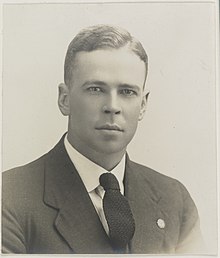
Back بيل بونسفورد Arabic بيل بونسفورد ARZ বিল পন্সফোর্ড Bengali/Bangla Bill Ponsford German بیل پونسفورد Persian Bill Ponsford French Bill Ponsford Italian बिल पॉन्सफोर्ड Marathi بل پونس فورڈ PNB Bill Ponsford Portuguese
 Studio portrait of William Ponsford, ca. 1925.jpg | ||||||||||||||||||||||||||||||||||||||||
| Personal information | ||||||||||||||||||||||||||||||||||||||||
|---|---|---|---|---|---|---|---|---|---|---|---|---|---|---|---|---|---|---|---|---|---|---|---|---|---|---|---|---|---|---|---|---|---|---|---|---|---|---|---|---|
| Full name | William Harold Ponsford | |||||||||||||||||||||||||||||||||||||||
| Born | 19 October 1900 Fitzroy North, Victoria, Australia | |||||||||||||||||||||||||||||||||||||||
| Died | 6 April 1991 (aged 90) Kyneton, Victoria, Australia | |||||||||||||||||||||||||||||||||||||||
| Nickname | Ponny, Puddin'[1] | |||||||||||||||||||||||||||||||||||||||
| Height | 5 ft 9 in (175 cm) | |||||||||||||||||||||||||||||||||||||||
| Batting | Right-handed | |||||||||||||||||||||||||||||||||||||||
| Bowling | Right-arm medium | |||||||||||||||||||||||||||||||||||||||
| Role | Opening batsman | |||||||||||||||||||||||||||||||||||||||
| International information | ||||||||||||||||||||||||||||||||||||||||
| National side | ||||||||||||||||||||||||||||||||||||||||
| Test debut (cap 117) | 19 December 1924 v England | |||||||||||||||||||||||||||||||||||||||
| Last Test | 22 August 1934 v England | |||||||||||||||||||||||||||||||||||||||
| Domestic team information | ||||||||||||||||||||||||||||||||||||||||
| Years | Team | |||||||||||||||||||||||||||||||||||||||
| 1921–1934 | Victoria | |||||||||||||||||||||||||||||||||||||||
| Career statistics | ||||||||||||||||||||||||||||||||||||||||
| ||||||||||||||||||||||||||||||||||||||||
Source: CricketArchive, 29 February 2008 | ||||||||||||||||||||||||||||||||||||||||
William Harold Ponsford MBE (19 October 1900 – 6 April 1991) was an Australian cricketer. Usually playing as an opening batsman, he formed a successful and long-lived partnership opening the batting for Victoria and Australia with Bill Woodfull, his friend and state and national captain. Ponsford is the only player to twice break the world record for the highest individual score in first-class cricket; Ponsford and Brian Lara are the only cricketers to twice score 400 runs in an innings. Ponsford holds the Australian record for a partnership in Test cricket, set in 1934 in combination with Don Bradman (451 for 2nd wicket)—the man who broke many of Ponsford's other individual records. In fact, he along with Bradman set the record for the highest partnership ever for any wicket in Test cricket history when playing on away soil (451 runs for the second wicket)[2]
Despite being heavily built, Ponsford was quick on his feet and renowned as one of the finest ever players of spin bowling. His bat, much heavier than the norm and nicknamed "Big Bertha", allowed him to drive powerfully and he possessed a strong cut shot. However, critics questioned his ability against fast bowling, and the hostile short-pitched English bowling in the Bodyline series of 1932–33 was a contributing factor in his early retirement from cricket a year and a half later.[3] Ponsford also represented his state and country in baseball, and credited the sport with improving his cricketing skills.
Ponsford was a shy and taciturn man. After retiring from cricket, he went to some lengths to avoid interaction with the public. He spent over three decades working for the Melbourne Cricket Club, where he had some responsibility for the operations of the Melbourne Cricket Ground (MCG), the scene of many of his great performances with the bat. In 1981 the Western Stand at the MCG was renamed the W.H. Ponsford Stand in his honour. This stand was demolished in 2003 as part of the redevelopment of the ground for the 2006 Commonwealth Games, but its replacement was also named the W.H. Ponsford Stand.[4] At the completion of the stadium redevelopment in 2005, a statue of Ponsford was installed outside the pavilion gates. In recognition of his contributions as a player, Ponsford was one of the ten initial inductees into the Australian Cricket Hall of Fame.
- ^ Robinson (1946), p. 145.
- ^ "Partnership records | Test matches | Cricinfo Statsguru". ESPNcricinfo. Retrieved 12 August 2017.
- ^ As a convention, cricket seasons are denoted as a single year to represent northern hemisphere summer, or dashed for southern hemisphere. See Cricket season for more information.
- ^ "Grandstands at the MCG". Melbourne Cricket Club. 2009. Retrieved 5 February 2011.
© MMXXIII Rich X Search. We shall prevail. All rights reserved. Rich X Search